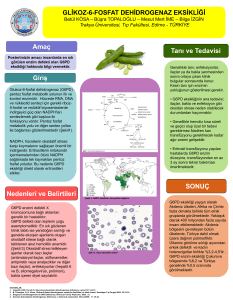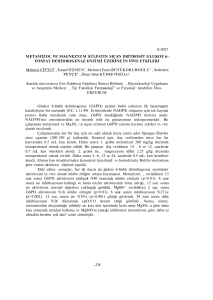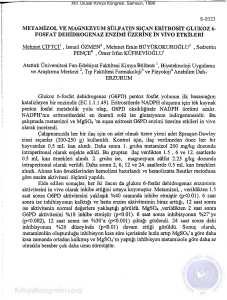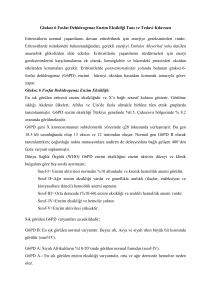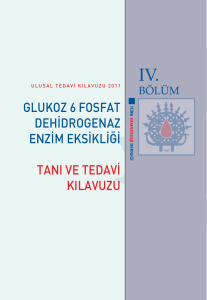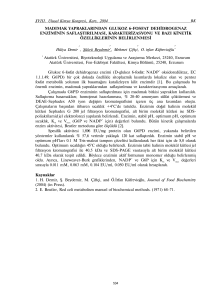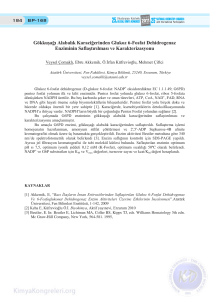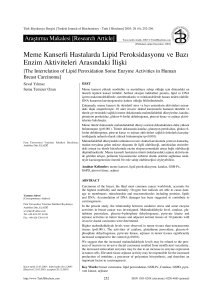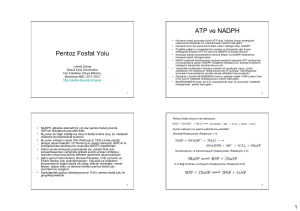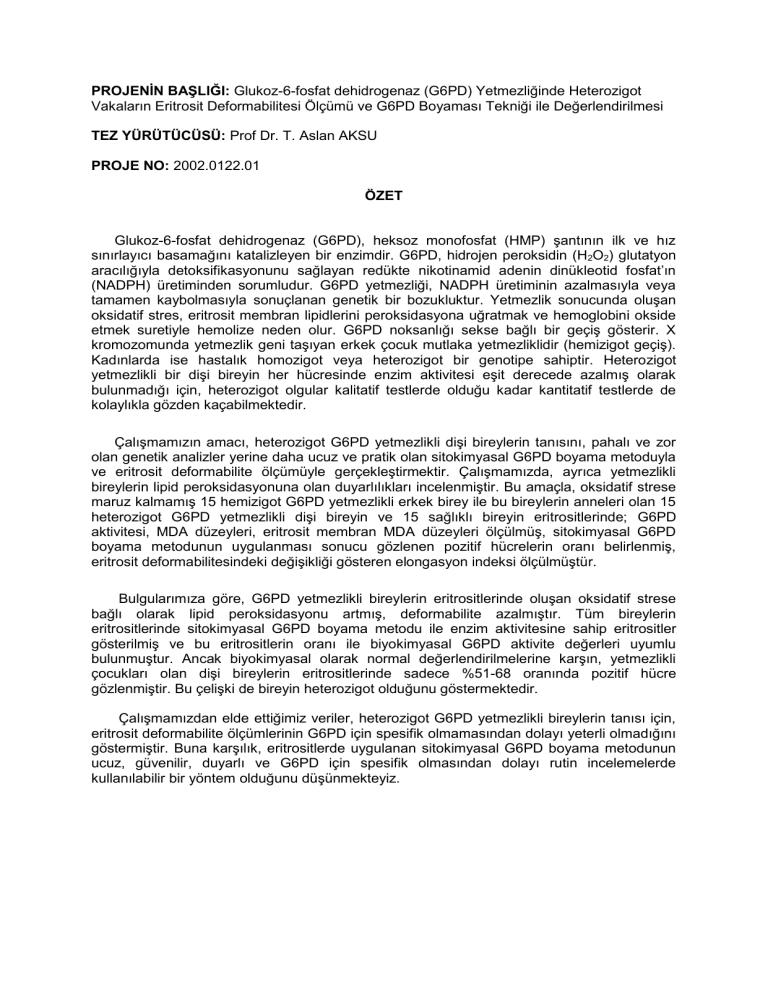
PROJENİN BAŞLIĞI: Glukoz-6-fosfat dehidrogenaz (G6PD) Yetmezliğinde Heterozigot
Vakaların Eritrosit Deformabilitesi Ölçümü ve G6PD Boyaması Tekniği ile Değerlendirilmesi
TEZ YÜRÜTÜCÜSÜ: Prof Dr. T. Aslan AKSU
PROJE NO: 2002.0122.01
ÖZET
Glukoz-6-fosfat dehidrogenaz (G6PD), heksoz monofosfat (HMP) şantının ilk ve hız
sınırlayıcı basamağını katalizleyen bir enzimdir. G6PD, hidrojen peroksidin (H2O2) glutatyon
aracılığıyla detoksifikasyonunu sağlayan redükte nikotinamid adenin dinükleotid fosfat’ın
(NADPH) üretiminden sorumludur. G6PD yetmezliği, NADPH üretiminin azalmasıyla veya
tamamen kaybolmasıyla sonuçlanan genetik bir bozukluktur. Yetmezlik sonucunda oluşan
oksidatif stres, eritrosit membran lipidlerini peroksidasyona uğratmak ve hemoglobini okside
etmek suretiyle hemolize neden olur. G6PD noksanlığı sekse bağlı bir geçiş gösterir. X
kromozomunda yetmezlik geni taşıyan erkek çocuk mutlaka yetmezliklidir (hemizigot geçiş).
Kadınlarda ise hastalık homozigot veya heterozigot bir genotipe sahiptir. Heterozigot
yetmezlikli bir dişi bireyin her hücresinde enzim aktivitesi eşit derecede azalmış olarak
bulunmadığı için, heterozigot olgular kalitatif testlerde olduğu kadar kantitatif testlerde de
kolaylıkla gözden kaçabilmektedir.
Çalışmamızın amacı, heterozigot G6PD yetmezlikli dişi bireylerin tanısını, pahalı ve zor
olan genetik analizler yerine daha ucuz ve pratik olan sitokimyasal G6PD boyama metoduyla
ve eritrosit deformabilite ölçümüyle gerçekleştirmektir. Çalışmamızda, ayrıca yetmezlikli
bireylerin lipid peroksidasyonuna olan duyarlılıkları incelenmiştir. Bu amaçla, oksidatif strese
maruz kalmamış 15 hemizigot G6PD yetmezlikli erkek birey ile bu bireylerin anneleri olan 15
heterozigot G6PD yetmezlikli dişi bireyin ve 15 sağlıklı bireyin eritrositlerinde; G6PD
aktivitesi, MDA düzeyleri, eritrosit membran MDA düzeyleri ölçülmüş, sitokimyasal G6PD
boyama metodunun uygulanması sonucu gözlenen pozitif hücrelerin oranı belirlenmiş,
eritrosit deformabilitesindeki değişikliği gösteren elongasyon indeksi ölçülmüştür.
Bulgularımıza göre, G6PD yetmezlikli bireylerin eritrositlerinde oluşan oksidatif strese
bağlı olarak lipid peroksidasyonu artmış, deformabilite azalmıştır. Tüm bireylerin
eritrositlerinde sitokimyasal G6PD boyama metodu ile enzim aktivitesine sahip eritrositler
gösterilmiş ve bu eritrositlerin oranı ile biyokimyasal G6PD aktivite değerleri uyumlu
bulunmuştur. Ancak biyokimyasal olarak normal değerlendirilmelerine karşın, yetmezlikli
çocukları olan dişi bireylerin eritrositlerinde sadece %51-68 oranında pozitif hücre
gözlenmiştir. Bu çelişki de bireyin heterozigot olduğunu göstermektedir.
Çalışmamızdan elde ettiğimiz veriler, heterozigot G6PD yetmezlikli bireylerin tanısı için,
eritrosit deformabilite ölçümlerinin G6PD için spesifik olmamasından dolayı yeterli olmadığını
göstermiştir. Buna karşılık, eritrositlerde uygulanan sitokimyasal G6PD boyama metodunun
ucuz, güvenilir, duyarlı ve G6PD için spesifik olmasından dolayı rutin incelemelerde
kullanılabilir bir yöntem olduğunu düşünmekteyiz.
ABSTRACT
Glucose-6-phosphate dehydrogenase (G6PD) is a housekeeping enzyme that catalysis
the first and rate limiting step in the hexose monophosphate (HMP) shunt. The key role for
G6PD is to provide NADPH, required for the detoxification of hydrogen peroxide, via
glutathione. G6PD deficiency is a common genetic disorder which results in a decreased or
nonexistent ability to generate NADPH. G6PD deficiency leads to enhanced lipid
peroxidation, hemoglobin oxidation and hemolytic anemia. The gene that encodes G6PD is
carried on the X chromosome. Thus, inheritance of G6PD deficiency is sex-linked. While
affected males fully express the genetic defect, affected females can either be homo or
heterozygous. In a heterozygous female, the random inactivation of the X chromosome
results in two populations of deficient and normal red blood cells. The qualitative and
quantitative screening tests for the detection of G6PD deficiency in heterozygous females
are not very reliable.
The aim of this study was to diagnose heterozygous females with an inexpensive and
practical cytochemical G6PD staining method and via erythrocyte deformability detection.
Successful accomplishment of the specific aim would allow the diagnosis of G6PD deficiency
without expensive and difficult genetic analysis. The susceptibility of G6PD deficient
individuals to lipid peroxidation was also evaluated in the reported study. Three groups were
included in the study. The first group consisted of 15 hemizygous G6PD deficient males. The
second and third group was composed of 15 heterozygous G6PD females and 15 healthy
individuals, respectively. Biochemical analysis of G6PD activity, erythrocyte MDA levels,
erythrocyte membrane MDA levels, cytochemical G6PD staining and the elongation index
showing the changes in erythrocyte deformability was detected in all groups of samples.
The reported data shows a significant increase in lipid peroxidation and a decrease in
red cell deformability. Erythrocytes possessing G6PD activity were demonstrated with a
cytochemical G6PD staining method and the results obtained by cytochemical analysis
significantly correlated with the biochemical data (p<0.001). However, only 51 to 68% of cells
were stained pozitif in females having normal G6PD activity but with G6PD deficient children.
This observation clearly indicates that these individuals are heterozygous.
These findings show that red cell deformability measurements are not specific and
therefore not sufficient for the diagnosis of G6PD deficiency. However, the cytochemical
staining method for G6PD has proven to be inexpensive, dependable, sensitive and specific.
Therefore this method can be used for rapid routine analysis of G6PD deficiency.

